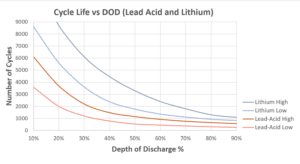Of the utmost importance for load control is to never allow the battery to be completely discharged. This can do irreversible harm to the battery bank. The LVD setting should also be set to disconnect the load before the battery reaches a very low SOC which can reduce the life expectancy of the battery bank. It is also possible to use higher LVD settings to limit the minimum SOC to increase life expectancy.
Cycle Life vs Depth of Discharge (DoD)
Battery manufacturers publish graphs for cycle life (aka number of cycles) vs DOD. Cycle life is the number of times that the battery is discharged and charged to the specified DOD before the battery’s Ah capacity drops below its rated capacity by a certain percentage. Below are examples of Cycle Life vs DOD graphs for lead-acid batteries and lithium batteries. Please note that these are examples only and are not representative for particular brands and models for these types of batteries.

As seen in the graphs above, Cycle Life vs DOD does not have a linear relationship. The higher the specified DOD is for each cycle the less overall energy (Ah, kWh) will be available for the system. Doubling the DOD will provide less than half the number of cycles available.
Lifetime Energy for a 100Ah Lead-Acid battery based on average DOD
Cycle Life (30% DoD) = 2,050 cycles; Cycle Life (80% DoD) = 630 cycles
Available Lifetime Energy (30% DOD) = 2,050 cycles X 30Ah = 61.5 kAh
Available Lifetime Energy (80% DOD) = 630 cycles X 80Ah = 50.4 kAh
Lithium batteries have a much higher cycle life than lead-acid batteries even with higher DOD levels. The cycle life of different types of lead-acid batteries can also vary. Therefore, the battery manufacturer’s cycle life specifications should always be reviewed when batteries are being specified for the system. It should also be noted that higher ambient temperatures and higher charge/discharge rates can reduce the expected cycle life of the battery.
Does this mean you should have higher LVD settings to extend the life of the battery? It depends. First, consider the difference between the Average DOD per Cycle vs. the Maximum DOD. Then consider how much the battery will be discharged on a daily basis (more on cloudy days; less on sunny days). A larger PV array will also be able to maintain a higher SOC and reduce the Average DOD and how often the battery is deeply discharged.
Though a very low LVD setting corresponds with a high Maximum DOD, the Average DOD per Cycle will be much lower and the battery should rarely, if ever, experience an LVD with the Maximum DOD. Therefore, if the system is sized properly to prevent a loss of load, higher LVD settings should not have much of an impact on the life of the battery.
In summary, the DOD for each discharge/ charge cycle will vary greatly. Using a low LVD setting doesn’t mean the battery will discharge to that level every day. If the system design and performance makes it so the battery is rarely deeply discharged, a lower LVD setting should not have a big impact on the life of the battery bank.The question remains, under what circumstances would higher LVD settings help extend the life of the battery?
- Frequent deep discharging of the battery due to one of the following
- Undersized PV array or poor performance of a PV array
- Underestimated load usage
- New loads added to the system
- Undersized battery bank
- Irregular load usage (common with residential applications)
- Systems that include a generator often have smaller battery banks
- Extended periods with a partial state of charge (PSOC) due to not being able to recover from a very deep discharge.
- Prevent freezing of the batteries in very cold climates
Using a lower LVD setting will provide more autonomy for the system. However the PSOC issues that can cause harm to lead-acid batteries may be exacerbated with lower SOC levels. It may be necessary to use higher LVD settings or take other measures as previously discussed to prevent PSOC issues when using lower LVD settings.
In very cold conditions lead-acid batteries can freeze and cause damage. The freezing point of lead-acid batteries increases the lower the SOC is and the specific gravity of the electrolyte is low. Therefore, a higher LVD setting should always be used in very cold environments to continuously maintain a high enough SOC and prevent freezing.

